List of Metropolitans and Patriarchs of Kiev
This list contains the names of all the hierarchs whose title contains a reference to the city of Kiev (except those of the Russian Orthodox Old-Rite Church who never styled themselves as either metropolitans or patriarchs in Kiev), arranged chronologically and grouped as per the jurisdictions, some of them unrecognised. Nearly all the hierarchs listed up to the 1920s, except the primates of the Ukrainian Greek Catholic Church, belonged to the Russian Orthodox Church, under the jurisdiction of the Patriarch of Constantinople at certain periods.
History
The history of the Russian Orthodox Church, as well as other Eastern Orthodox Church bodies in existence in modern Ukraine, is usually traced to the Baptism of Rus' at Kiev, the date of which is commonly given as 988; however, the evidence surrounding this event is contested (see Christianisation of Kievan Rus').
Ecumenical Patriarch of Constantinople in Kievan Rus
Metropolitans of Kiev and all Rus' (988–1458)
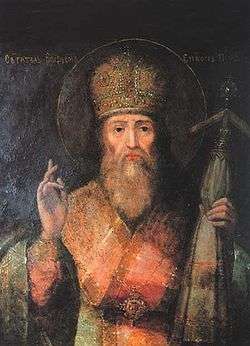
- Michael I, 988(?)–992(?)
- Leontius, 988(?)–1004(?) [1]
- John, 1008(?)–1017(?) [2]
- Teopempt 1037(?)–1043(?) [2]
- Hilarion 1051–(?) [3]
- Ephraim, 1055(?)–(?) [4]
- Jurij, 1072(?)–(?) [4]
- John Prodrom, 1077(?)–1089 [5]
- John, 1090–1091 [5]
- Ephraim of Pereyaslavl, 1091–1097
- Nicholas, 1097–1101(?) [6]
- Nikephoros, 1104–1121 [6]
- Nikita, 1122–1126 [7]
- Michael, 1130(?)–1145(?) [7]
- Kliment Smoliatich, 1147–1159
- Kostantyn, 1156–1159 [8]
- Teodor, 1161–1163 [8]
- John, 1164–1166 [8]
- Costantine, 1167–1177(?) [9]
- John (?)–(?) [9]
- Nikephoros, 1182(?)–1197(?) [9]
- Matthew, 1210(?)–1220 [10]
- Сyril, 1224–1233 [10]
- Joseph, 1237–(?) [10]
- Peter Akerovich, 1244–1246
- Cyril, 1250–1281 [11]
- Maximus, 1283–1299
In 1299 Metropolitan Maximus moves the seat from Kiev to Vladimir, title "of Kiev" retained.
Ecumenical Patriarch of Constantinople in Grand Duchy of Moscow
Vladimir period (1299–1325)
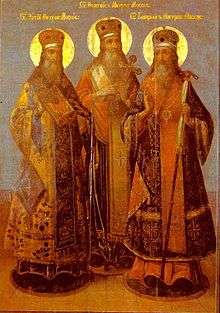
In 1325 the seat is moved to Moscow
Moscow period (1325–1461)
- vacant, 1326–1328
- Theognostus, 1328–1353
- Teodorite (anti-Metropolitan), 1352 [12]
- Alexius, 1354–1378
- Roman (anti-Metropolitan), 1354–1362 [13]
- Cyprian, 1376–1406 [14]
- Dionysius I (anti-Metropolitan), 1384–1385
- Pimen (anti-Metropolitan), 1382–1389
- Photius, 1410–1431
- Gregory Tsamblak (anti-Metropolitan), 1415–1419 [15]
- Gerasimus, 1433–1435 [16]
- Isidore, 1436–1441
- vacant, 1441–1448
- Jonah, 1448–1461[lower-alpha 1]
In 1448, shortly before the fall of Constantinople in 1453, with the political rise of the Grand Duchy of Moscow and the dominance of the Uniates in Constantinople, the Russian Orthodox metropolitanate became de facto autocephalous within the territory of the Grand Duchy of Moscow. After Jonah died in 1461, the reference to Kiev in the title of metropolitans in Moscow was dropped; his successors in Moscow were styled as "of Moscow and All Rus'." By 1458, the Orthodox dioceses within the territory of the Grand Duchy of Lithuania, including Kiev, were restored to the jurisdiction of the Ecumenical Patriarchate, with a re-established Metropolitanate of Kiev (1458–1596), initially with its metropolitan episcopal see in Vilnius, the capital of the Grand Duchy of Lithuania.
Ecumenical Patriarch of Constantinople in Grand Duchy of Lithuania
Metropolitans of Kiev, Galicia and All Rus'
Patriarch Isidore II of Constantinople re-established the Metropolitanate of Kiev (1458–1596) in 1458 and gave its metropolitan a new title: Metropolitan of Kiev, Galicia, and All Rus'.
Vilno period (1458–1595)
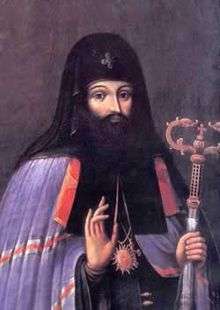
- Gregory the Bulgarian, 1458–1473 – Appointed by Pope Pius II
- Misail Pstruch, 1476–1480 [17] – Accepted by Casimir IV Jagiellon, king of Poland and grand duke of Lithuania, after agreeing to adopt the 1439 Union of Florence
- Spyridon Satana (anti-Metropolitan), 1476–1482 [18] – Consecrated as Metropolitan of Kiev by Patriarch Raphael I of Constantinople but rejected by Casimir IV
- Symeon, metropolitan of Kyiv, 1481–1488 [18]
- Jonah Hlezna, 1489–1494 [19]
- Macarius Chort, 1495–1497 [19]
- Joseph Bolharynovich, 1499–1501 [19]
- Jonah, metropolitan of Kyiv, 1503–1507 [20]
- Joseph Soltan, 1509–1522 [20]
- Joseph Rusin, 1523–1533 [20]
- Macarius Moskovytyanyn, 1534–1555 [21]
- Sylvester Bilkevich, 1556–1567 [21]
- Jonah Protasevich, 1568–1577 [21]
- Elias Kucha, 1577–1579 [22]
- Onesiphorus Devochka, 1579–1589 [22]
- Michael Rohoza, 1589–1599
In 1595 the Vilno/Kiev Metropolia signs the Union of Brest with the Catholic Church, so establishing the Ukrainian Greek Catholic Church. For the list of Primates in communion with the Catholic Church, see § List of Greek Catholic Primates.
Second Kiev Period (1620–1686)
In 1620 – about 25 years after the implementation of the Union of Brest – Patriarch Cyril Lucaris, of Constantinople, re-established a rival Metropolitanate of Kiev (1620–1685) with a disuniate hierarchy, within the Polish–Lithuanian Commonwealth.[23][lower-alpha 2]
- Job Boretsky, 1620–1631
- Isaiah Kopinsky, 1631–1633[lower-alpha 3]
- Peter Mogila, 1633–1646
- Sylvester Kossov, 1647–1657
|
Appointed by Moscow (residence in Kiev):[26]
|
Following the 1654 Pereyaslav agreement, the Greek Orthodox Metropolitanate of Kiev was in 1686 transferred from the Ecumenical Patriarchate to the Moscow Patriarchate.
The Moscow Patriarchate
Metropolitans of Kiev, Galicia and of All Little Rus' (1685–1770)
- Gedeon (Svyatopolk-Chetvertynsky), 1685–1690 [31] (Former bishop of Lutsk, Gedeon Chetvertinsky was elected by the sobor initiated by the Hetman Ivan Samoilovych and later went for consecration to Moscow instead of Constantinople)
- Barlaam Yasynsky (also spelled as Varlaam Yasinsky), 1690–1707 [31]
- Ioasaph Krakovsky, 1708–1718 [31]
- Barlaam Vanatovich, 1722–1730 [31]
- Raphael Zaborovsky, 1731–1747
- Timothy Shcherbatsky, 1748–1757 [31]
- Arsenius Mohylyansky, 1757–1770 [31]
Metropolitans and Archbishops of Kiev and Galicia (1770–1990)
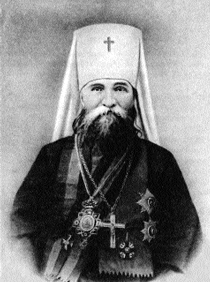
- Gabriel Kremenetsky, 1770–1783 [31]
- Samuel Mstislavsky, 1783–1796 [31]
- Hierotheus Malytsky, 1796–1799 [31]
- Gabriel Banulesko-Bodoni, 1799–1803 [31]
- Serapion Alexandrovsky, 1803–1822 [31]
- Eugene Bolkhovitinov, 1822–1837 [31]
- Philaret Amphiteatrov, 1837–1857 [31]
- Isidore Nikolsky, 1858–1860 [31]
- Arsenius Moskvin, 1860–1876 [31]
- Philotheus Uspensky, 1876–1882 [31]
- Platon Gorodetsky, 1882–1891 [31]
- Joanicius Rudnev, 1891–1900 [31]
- Theognostus Lebedev, 1900–1903 [31]
- Flavian Gorodetsky, 1903–1915 [31]
- Vladimir Bogoyavlensky, 1915–1918 [31]
Metropolitans and Archbishops of Kiev and Galicia (Ukrainian Autonomous Orthodox Church)
- Anthony Khrapovitsky, 1918–1919 [31]
- Nazarius Blinov, 1919–1921 [31]
Metropolitans and Archbishops of Kiev and Galicia (Exarch of Ukraine)
- Michael Yermakov, 1921–1925,[31] exarch of Ukraine 1921-1929
- Georges Deliev, 1923–1928 [31]
- Macarius Karamzin, 1924 [31]
- Sergius Kuminsky, 1925–1930 [31]
- Demetrius Verbitsky, 1930–1932 [31]
- Sergius Grishin, 1932–1934 [31]
- Constantine Dyakov, 1934–1937,[31] exarch of Ukraine 1929-1937
- Alexander Petrovsky, 1937–1938 [31]
- Nicholas Yarushevich, 1941–1944,[31] exarch of Ukraine 1941
- During World War II all territory of Ukraine was occupied by the Nazi Germany therefore Metropolitan Nicholas moved to Moscow. The rest of bishops loyal to Moscow Patriarchate created Ukrainian Autonomous Orthodox Church which was recognized by Metropolitan Nicholas. With the end of German occupation Ukrainian Autonomous Orthodox Church was dissolved and incorporated back to the Russian Orthodox Church (Ukrainian Exarchate).
- Oleksii Hromadskyi, 1941–1943 (Ukrainian Autonomous Orthodox Church)[32]
- Panteleimon Rudyk, 1943–1944 (Ukrainian Autonomous Orthodox Church)[31][33]
- John Sokolov, 1944–1964,[31] exarch of Ukraine
- Ioasaph Leliukhin, 1964–1966,[31] exarch of Ukraine
- Philaret Denisenko, 1966–1990,[31] exarch of Ukraine
In 1990 the Ukrainian Exarchate of the Russian Orthodox Church, is given "self-ruled" status forming the Ukrainian Orthodox Church (Moscow Patriarchate)
Metropolitans of Kiev and All Ukraine
- Philaret Denisenko, 1990–1992 (joined the newly formed Ukrainian Orthodox Church (Kiev Patriarchate) in 1992, excommunicated by the Moscow Patriarchate in 1997)
- Volodymyr Sabodan, 1992–2014
- Metropolitan Onuphrius,[34] 2014–Incumbent
Ukrainian Greek Catholic Church
Following the Union of Brest in 1596, some of the Orthodox bishops of the Metropolia of Kiev-Halych and all Rus (in the Polish–Lithuanian Commonwealth) broke up with the Patriarch of Constantinople and placed themselves under the Bishop of Rome, thus establishing what later became known as the "Ukrainian Greek Catholic Church". The residence of the Metropolitan had to be moved in the early 17th century to Navahrudak and later to Vilnius. At first widely successful, within several decades it had lost much of its initial support, mainly due to persecution of its clergy by the Tsardom of Muscovy once those areas that had previously been part of the Polish-Lithuanian Commonwealth were conquered by Moscow, though in Galicia, which was governed by the Habsburg Empire, the church fared well and remains strong to this day.
Primates from 1596 to 1807
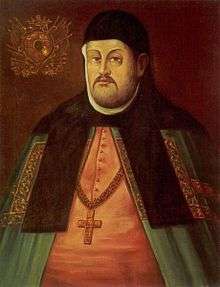
Metropolitans of Kiev, Galich and All Rus':
- Mykhajlo Rohoza, 1589–1599
- Ipatii Potii, 1600–1613
- Josyf Veliamyn Rutsky, 1613–1637
- Rafajil Korsak, 1637–1640
- Antin Sielava, 1641–1655
- Havryil Kolenda, 1666–1674
- Kyprian Zochovskyj, 1674–1693
- Lev Szlubic-Zalenskyj, 1694–1708
- Yurij Vynnyckyj, 1708–1713
- Lev Luka Kiszka, 1714–1729
- Atanasiy Sheptytskyi, 1729–1746 [35]
- Florian Hrebnicky, 1748–1762 [35]
- Felicjan Filipp Wołodkowicz, 1762–1778 [35]
- Ludovik Lev Sheptytsky, 1778–1779 [35]
- Yakov Smogorzhevsky, 1780–1786 [35]
- Teodor Rostotsky, 1787–1805 [35]
Primates from 1807 to 2005
In 1807, the Greek Catholic Metropolia of Kiev, Galich and All Rus' was split to separate the territories in the Russian Empire (Metropolia of Kiev) from the those under the Habsburg Monarchy, thus elevating the Eparchy of Lviv to the rank of Metropolis and granting it the same rights of the Metropolis of Kiev.
Metropolitans of Kiev, Galich and All Rus' from 1807 to 1838
Following the Synod of Polotsk (1839), the Greek Catholic church was liquidated in the territory of the Russian Empire (except the Eparchy of Kholm), and its property and clergy transferred to the Orthodox Church.
Primates from 2005
In 2005, the two distinct Greek Catholic Metropolias of Kiev and Lviv were re-united, as was the case prior to 1807.
Major Archbishop of Kiev–Halych:
- Lubomyr Husar, 2005–2011
- Sviatoslav Shevchuk, 2011–present
Ukrainian Autocephalous Orthodox Church
Metropolitan of Kyiv and All Ukraine (1921–1936)
- Vasyl Lypkivsky, 1921–1927
- Mykola Boretsky, 1927–1930 [36]
- Ivan Pavlovsky, 1930–1936 [36]
Due to Soviet pressure, the UAOC is liquidated in 1936.
UAOC during World War II (1942–1944)
In 1942, Orthodox Ukrainians enjoyed somewhat increased freedom under Nazi Germans who allowed to re-establish the UAOC on its occupied territory.
- Polikarp Sikorsky, (Administrator of the Church under the title of Metropolitan of Lutsk and Kovel), 1942–1944 [32]
This relative freedom lasted till the return of the Red Army in 1944, after that the UAOC was again liquidated and remained structured only in the diaspora. In 1944 the Orthodox Metropolitan of Warsaw, Dionizy Waledynski, was appointed "Patriarch of All Ukraine", but the Soviet Union did not allowed any operation in Ukraine.
Patriarchs of Kiev and all Rus-Ukraine from 1990
In 1990 the Ukrainian Autocephalous Orthodox Church was reinstated in Ukraine, and the former Ukrainian Orthodox Church of Canada Metropolitan Mstyslav was enthroned as a Patriarch.
- Stepan Mstyslav, 1991–1993
- Dmytro Yarema, 1993–2000
Metropolitans of Kiev and All Ukraine
- Mefodiy Kudriakov, 2000–2015 (deceased)
- Makariy Maletych 2015– (incumbent)
The Living Church metropolitans of Kiev
In 1923, a major split occurred in the Moscow Patriarchate, with a majority (initially) of the ROC bishops joining a reformist-minded wing of the Church, supported by the OGPU, the Soviet secret police. Across the territory of the USSR, many episcopal sees in the 1920s and 1930s had 2 parallel bishops: one from the Living Church, another from the Moscow Patriarchate.
- Tikhon (Vasilevsky), 1923
- Nikolay (Fedotov), 1923–1924
- Aleksandr (Shcherbakov), 1924
- Innokentiy (Pustynsky), 1924–1929
- Iuvenaliy (Moshkovsky), 1928–1929
- Pimen (Pegov), 1929–1935
- Aleksandr (Chekanovsky), 1935–1937
- Vladimir (Zlobin), 1938–1941
Ukrainian Orthodox Church - Kiev Patriarchate
Patriarchs of Kiev and All Rus-Ukraine
In 1992 the Ukrainian Orthodox Metropolitan Filaret, stepped down from his throne at a Russian Orthodox Church synod in Moscow, upon his return to Kiev announces a split from the Russian Orthodox Church, and a union with the UAOC's patriarchate, creating a new Ukrainian Orthodox Church - Kiev Patriarchate (UOC–KP).
- Mstyslav Skrypnyk, 1991–1993
After Mstyslav died in 1993, the temporary union ended and the UOC–KP and UAOC separated.
- Volodymyr Romaniuk, 1993–1995
- Filaret Denysenko, 1995– incumbent
See also
Notes
- ↑ In 1448, bishops at Moscow elected Jonah without the approval of Patriarch Gregory III of Constantinople.
- ↑ King Sigismund III Vasa accused their consecrator, Theophanes III, Greek Orthodox Patriarch of Jerusalem, of being a covert agent working on behalf of the Ottoman Empire and ordered his arrest and arrest of those consecrated by him.[24]
- ↑ The hierarchy which was consecrated in 1620 was legalized by the government in a 1632 agreement that permitted both the disuniate Greek Orthodox and uniate Greek Catholic jurisdictions within the Polish–Lithuanian Commonwealth.[25]
Citations
- ↑ Blazejovskyj 1990, p. 64.
- 1 2 Blazejovskyj 1990, p. 65.
- ↑ Blazejovskyj 1990, p. 66.
- 1 2 Blazejovskyj 1990, p. 77.
- 1 2 Blazejovskyj 1990, p. 78.
- 1 2 Blazejovskyj 1990, p. 79.
- 1 2 Blazejovskyj 1990, p. 80.
- 1 2 3 Blazejovskyj 1990, p. 81.
- 1 2 3 Blazejovskyj 1990, p. 82.
- 1 2 3 Blazejovskyj 1990, p. 83.
- ↑ Blazejovskyj 1990, p. 84.
- ↑ Blazejovskyj 1990, p. 86.
- ↑ Blazejovskyj 1990, p. 87.
- ↑ Blazejovskyj 1990, pp. 88–90.
- ↑ Blazejovskyj 1990, p. 90.
- ↑ Blazejovskyj 1990, p. 91.
- ↑ Blazejovskyj 1990, p. 179.
- 1 2 Blazejovskyj 1990, p. 180.
- 1 2 3 Blazejovskyj 1990, p. 181.
- 1 2 3 Blazejovskyj 1990, p. 182.
- 1 2 3 Blazejovskyj 1990, p. 183.
- 1 2 Blazejovskyj 1990, p. 184.
- ↑ Subtelny 2009, p. ?; Crummey 2006, p. 305; Medlin & Patrinelis 1971, p. 90; Krasinski 1840, p. 191.
- ↑ Medlin & Patrinelis, pp. 89–90.
- ↑ Subtelny, p. ?.
- 1 2 Senyk 1996, pp. 354–357.
- ↑ Blazejovskyj 1990, p. 223.
- ↑ Blazejovskyj 1990, p. 225.
- ↑ Blazejovskyj 1990, p. 226.
- 1 2 3 Blazejovskyj 1990, p. 224.
- 1 2 3 4 5 6 7 8 9 10 11 12 13 14 15 16 17 18 19 20 21 22 23 24 25 26 27 28 29 30 31 32 33 34 35 36 UOC-MP 2011.
- 1 2 Magocsi 1996, p. 628.
- ↑ Blazejovskyj 1990, p. 405.
- ↑ "Metropolitan Onufriy of Chernivtsi and Bukovyna elected head of Ukrainian Orthodox Church (Moscow Patriarchate)". interfax.com.ua. Kyiv, UA: Interfax-Ukraine. 2014-08-13. Archived from the original on 2014-08-13.
- 1 2 3 4 5 6 7 8 9 Pelesz 1881, p. 1084
- 1 2 Blazejovskyj 1990, p. 428.
References
- This article incorporates text from List of Metropolitans of Kiev at OrthodoxWiki which is licensed under the CC-BY-SA and GFDL.
- Blažejovskyj, Dmytro (1990). Hierarchy of the Kyivan Church (861–1990). Vydanni͡a Ukraïnsʹkoho katolʹytsʹkoho universytetu im. Sv. Klymenta Papy Editiones Universitatis Catholicae Ucrainorum S. Clementis Papae Sacrum Ucrainae millenium. 72. Rome: [Ukraïnsʹkyĭ katolyt͡sʹkyĭ universytet im. Sv. Klymenta Papy]. OCLC 22834909.
- Crummey, Robert O. (2006). "Eastern Orthodoxy in Russia and Ukraine in the age of counter-Reformation". In Angold, Michael. Eastern Christianity. The Cambridge history of Christianity. 5. Cambridge: Cambridge University Press. pp. 302–324. doi:10.1017/CHOL9780521811132.014. ISBN 9780521811132 – via Cambridge Histories Online.
- Krasiński, Waleryan (1840). Historical sketch of the rise, progress and decline of the reformation in Poland. 2. London: J. L. Cox and Sons. OCLC 714971939.
- Pelesz, Julian (1881). Geschichte der Union der ruthenischen Kirche mit Rom. Woerl.
- Senyk, Sophia (1996). "The Ukrainian Church in the seventeenth century". Analecta Ordinis S. Basilii Magni. Rome: sumptibus PP. Basilianorum (Sectio II, vol XV (XXI), Fasc 1–4).
- "Metropolitans of Kyiv". orthodox.org.ua. Ukrainian Orthodox Church (Moscow Patriarchate). 2011-01-14. Archived from the original on 2011-10-02. Retrieved 2011-05-18.
- Magocsi, Paul (1996). A history of Ukraine. Toronto Buffalo: University of Toronto Press. ISBN 978-0-8020-7820-9.
- Medlin, William K.; Patrinelis, Christos G. (1971). Renaissance influences and religious reforms in Russia : Western and post-Byzantine impacts on culture and education (16th-17th centuries). Études de philologie et d'histoire. 18. Genève: Librairie Droz. ISBN 9782600038942.
- Subtelny, Orest (2009). Ukraine: a history (4th ed.). Toronto [u.a.]: University of Toronto Press. ISBN 978-1-44269728-7.
External links
- List of Orthodox Metropolitans of Ukraine
- Ukrainian Orthodox Church (Moscow Patriarchate) website
- Київські митрополити (до 1708 року) (Ukrainian)